2004 FORD MUSTANG tire pressure
[x] Cancel search: tire pressurePage 130 of 240

Fuse/Relay
LocationFuse Amp
RatingPower Distribution Box
Description
13 30A* MACH 1000 left amplifiers
14 20A* Fuel pump
15 30A* MACH 1000 right amplifiers
16 20A* Horn
17 20A* ABS
18 30A* Power seats
19 10A* Intercooler pump (Cobra
only)
20 20A* Alternator
21—Not used
22—Not used
23—Not used
24 20A* A/C pressure
25—Not used
26 30A** PCM
27 20A** Daytime Running Lamps
(DRL) module, Foglamp
relay
28 25A CB Convertible top circuit
breaker
29—Not used
* Mini Fuses ** Maxi Fuses
CHANGING A FLAT TIRE
If you get a flat tire while driving:
•do not brake heavily.
•gradually decrease the vehicle’s speed.
•hold the steering wheel firmly.
•slowly move to a safe place on the side of the
road.
The use of tire sealants may damage your
tires.
Temporary spare tire information
Your vehicle may have a temporary spare tire which
is labeled as such. It is smaller than a regular tire
2004 Mustang(mus)
Owners Guide (post-2002-fmt)
USA English(fus)
Roadside Emergencies
130
Page 131 of 240
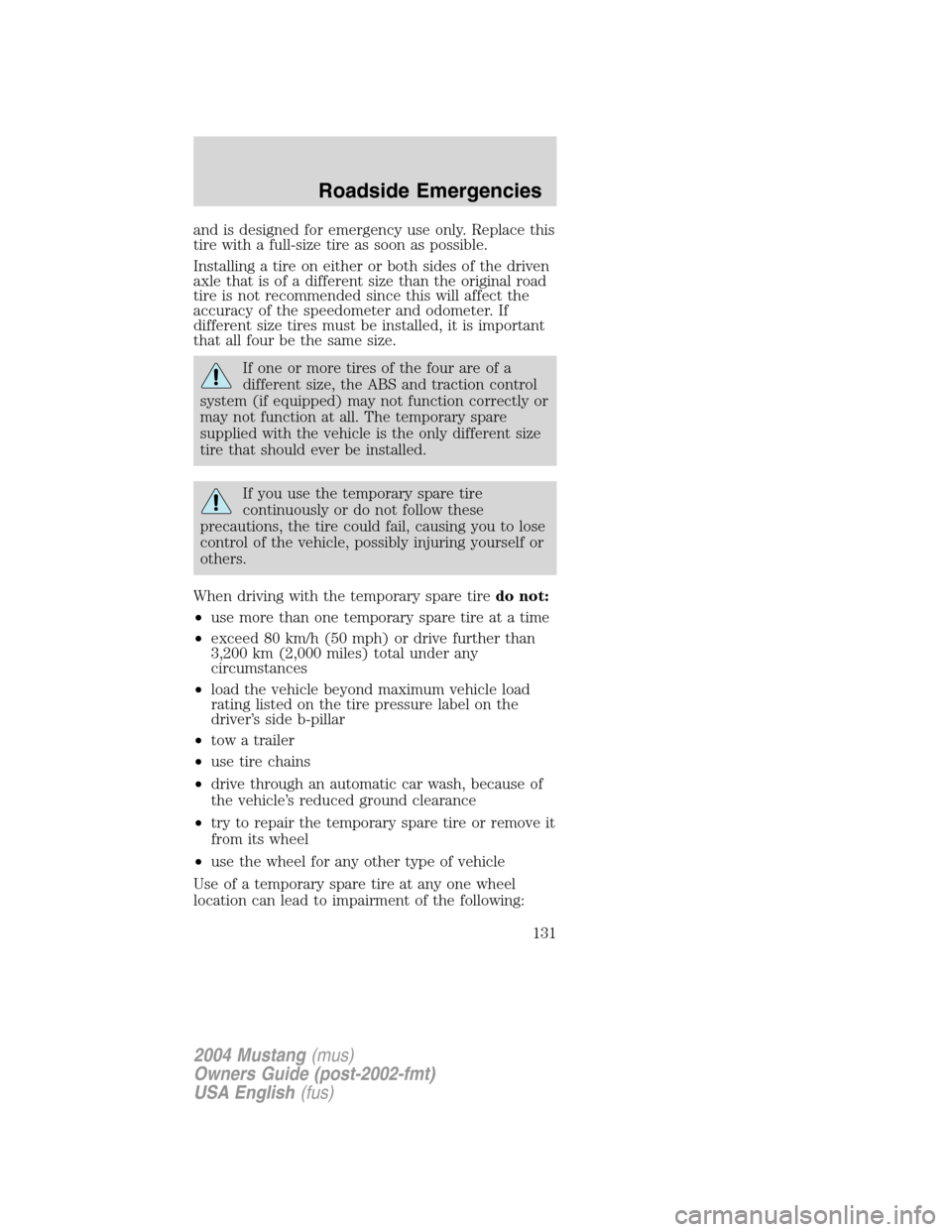
and is designed for emergency use only. Replace this
tire with a full-size tire as soon as possible.
Installing a tire on either or both sides of the driven
axle that is of a different size than the original road
tire is not recommended since this will affect the
accuracy of the speedometer and odometer. If
different size tires must be installed, it is important
that all four be the same size.
If one or more tires of the four are of a
different size, the ABS and traction control
system (if equipped) may not function correctly or
may not function at all. The temporary spare
supplied with the vehicle is the only different size
tire that should ever be installed.
If you use the temporary spare tire
continuously or do not follow these
precautions, the tire could fail, causing you to lose
control of the vehicle, possibly injuring yourself or
others.
When driving with the temporary spare tire do not:
• use more than one temporary spare tire at a time
• exceed 80 km/h (50 mph) or drive further than
3,200 km (2,000 miles) total under any
circumstances
• load the vehicle beyond maximum vehicle load
rating listed on the tire pressure label on the
driver’s side b-pillar
• tow a trailer
• use tire chains
• drive through an automatic car wash, because of
the vehicle’s reduced ground clearance
• try to repair the temporary spare tire or remove it
from its wheel
• use the wheel for any other type of vehicle
Use of a temporary spare tire at any one wheel
location can lead to impairment of the following:
2004 Mustang (mus)
Owners Guide (post-2002-fmt)
USA English (fus)
Roadside Emergencies
131
Page 135 of 240

replaced with a special key. The key and registration
card are attached to the lug wrench and stored with
the spare tire. If you lose the key, send the
registration card to the manufacturer (not the
dealer) to get a replacement key. If the lug
wrench/lug nut key assembly is lost, see your
nearest Ford or Lincoln Mercury dealer who has
access to the master set of keys.Do not use an
impact wrench with the anti-theft key.
To remove the
anti-theft lug nut:
1. Insert the key over
the locking lug nut.
Make sure you hold the key square to the lug nut. If
you hold the key at an angle, you could damage the
key and the lug nut.
2. Place the lug nut wrench over the lug nut key and
apply pressure on the key with the wrench.
3. Turn the wrench in a counterclockwise direction
to remove the lug nut.
To install the anti-theft lug nut:
1. Insert the key over the locking lug nut.
2. Place the lug nut wrench over the lug nut key and
apply pressure on the key with the wrench.
3.
Install the lug nut by turning the wrench clockwise.
Wheel lug nut torque specifications
Retighten the lug nuts to the specified torque at
800 km (500 miles) after any wheel disturbance
(tire rotation, changing a flat tire, wheel removal,
etc.).
Bolt size Wheel lug nut torque*
Nm Lb-ft
1⁄2x 20 120-147 88-108
* Torque specifications are for nut and bolt threads free of
dirt and rust. Use only Ford recommended replacement
fasteners.
2004 Mustang (mus)
Owners Guide (post-2002-fmt)
USA English (fus)
Roadside Emergencies
135
Page 179 of 240
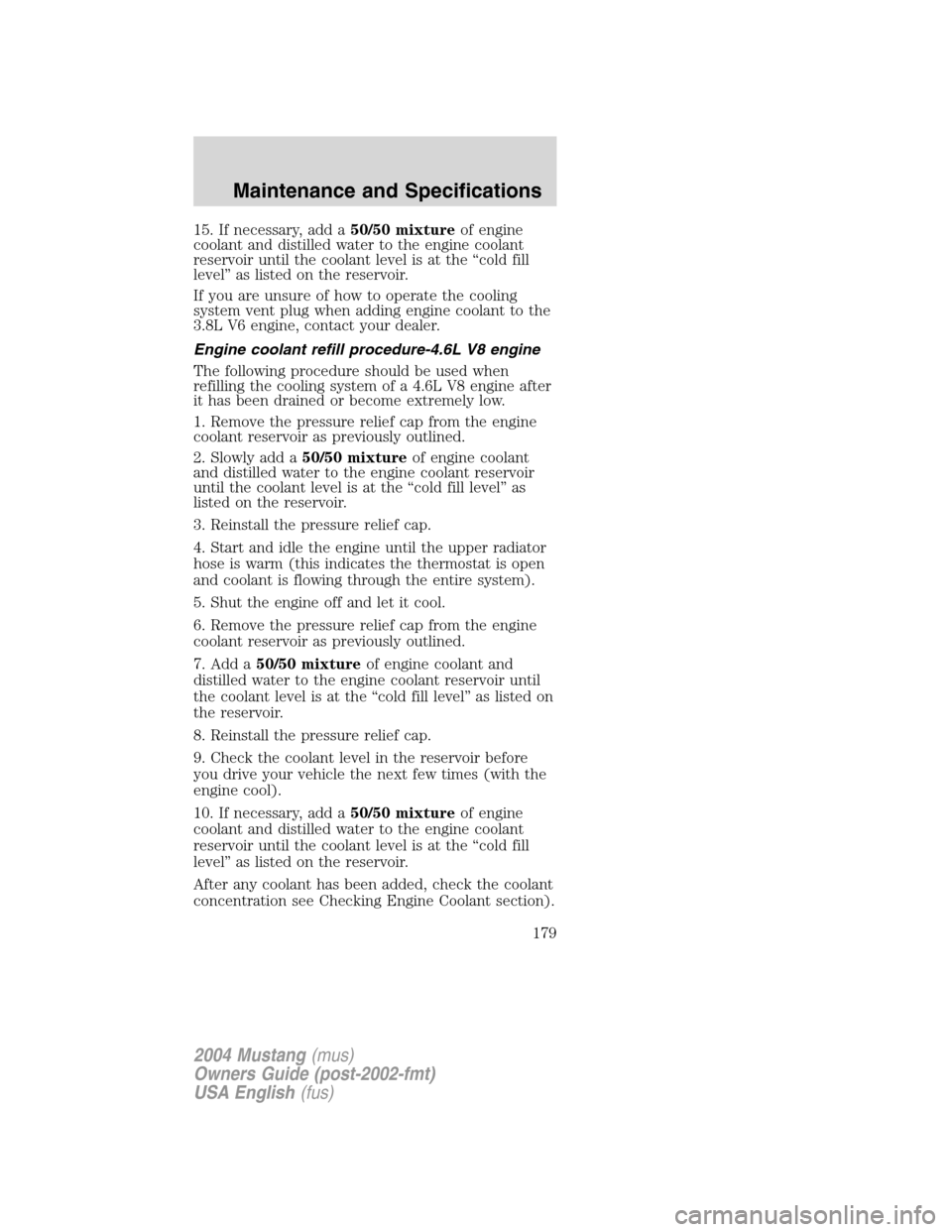
15. If necessary, add a50/50 mixtureof engine
coolant and distilled water to the engine coolant
reservoir until the coolant level is at the“cold fill
level”as listed on the reservoir.
If you are unsure of how to operate the cooling
system vent plug when adding engine coolant to the
3.8L V6 engine, contact your dealer.
Engine coolant refill procedure-4.6L V8 engine
The following procedure should be used when
refilling the cooling system of a 4.6L V8 engine after
it has been drained or become extremely low.
1. Remove the pressure relief cap from the engine
coolant reservoir as previously outlined.
2. Slowly add a50/50 mixtureof engine coolant
and distilled water to the engine coolant reservoir
until the coolant level is at the“cold fill level”as
listed on the reservoir.
3. Reinstall the pressure relief cap.
4. Start and idle the engine until the upper radiator
hose is warm (this indicates the thermostat is open
and coolant is flowing through the entire system).
5. Shut the engine off and let it cool.
6. Remove the pressure relief cap from the engine
coolant reservoir as previously outlined.
7. Add a50/50 mixtureof engine coolant and
distilled water to the engine coolant reservoir until
the coolant level is at the“cold fill level”as listed on
the reservoir.
8. Reinstall the pressure relief cap.
9. Check the coolant level in the reservoir before
you drive your vehicle the next few times (with the
engine cool).
10. If necessary, add a50/50 mixtureof engine
coolant and distilled water to the engine coolant
reservoir until the coolant level is at the“cold fill
level”as listed on the reservoir.
After any coolant has been added, check the coolant
concentration see Checking Engine Coolant section).
2004 Mustang(mus)
Owners Guide (post-2002-fmt)
USA English(fus)
Maintenance and Specifications
179
Page 202 of 240
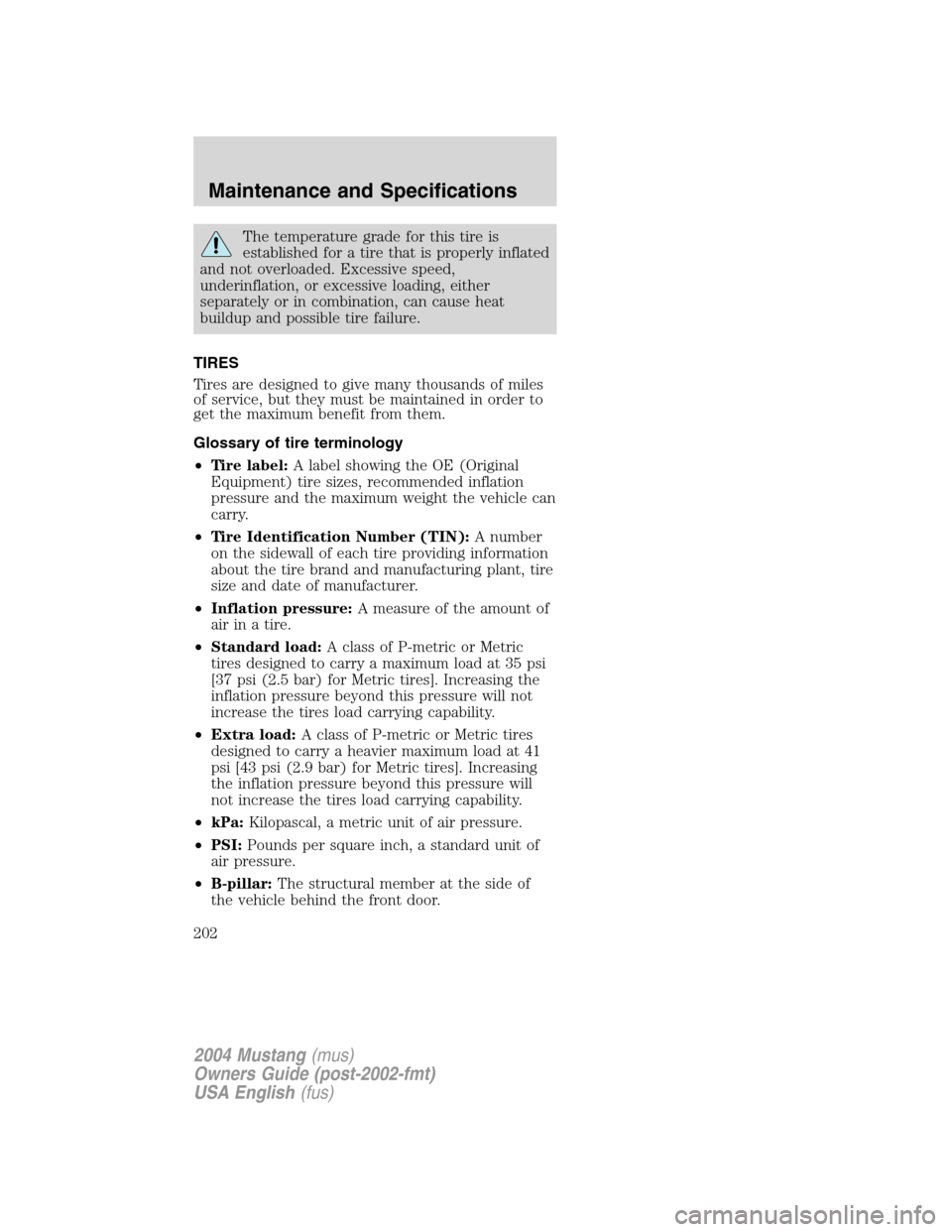
The temperature grade for this tire is
established for a tire that is properly inflated
and not overloaded. Excessive speed,
underinflation, or excessive loading, either
separately or in combination, can cause heat
buildup and possible tire failure.
TIRES
Tires are designed to give many thousands of miles
of service, but they must be maintained in order to
get the maximum benefit from them.
Glossary of tire terminology
•Tire label:A label showing the OE (Original
Equipment) tire sizes, recommended inflation
pressure and the maximum weight the vehicle can
carry.
•Tire Identification Number (TIN):A number
on the sidewall of each tire providing information
about the tire brand and manufacturing plant, tire
size and date of manufacturer.
•Inflation pressure:A measure of the amount of
air in a tire.
•Standard load:A class of P-metric or Metric
tires designed to carry a maximum load at 35 psi
[37 psi (2.5 bar) for Metric tires]. Increasing the
inflation pressure beyond this pressure will not
increase the tires load carrying capability.
•Extra load:A class of P-metric or Metric tires
designed to carry a heavier maximum load at 41
psi [43 psi (2.9 bar) for Metric tires]. Increasing
the inflation pressure beyond this pressure will
not increase the tires load carrying capability.
•kPa:Kilopascal, a metric unit of air pressure.
•PSI:Pounds per square inch, a standard unit of
air pressure.
•B-pillar:The structural member at the side of
the vehicle behind the front door.
2004 Mustang(mus)
Owners Guide (post-2002-fmt)
USA English(fus)
Maintenance and Specifications
202
Page 204 of 240

2.215:Indicates the nominal width of the tire in
millimeters from sidewall edge to sidewall edge. In
general, the larger the number, the wider the tire.
3.65:Indicates the aspect ratio which gives the
tire’s ratio of height to width.
4.R:Indicates a“radial”type tire.
5.15:Indicates the wheel or rim diameter in inches.
If you change your wheel size, you will have to
purchase new tires to match the new wheel
diameter.
6.95:Indicates the tire’s load index. It is an index
that relates to how much weight a tire can carry.
You may find this information in your owner’s guide.
If not, contact a local tire dealer.
Note:You may not find this information on all tires
because it is not required by federal law.
7.H:Indicates the tire’s speed rating. The speed
rating denotes the speed at which a tire is designed
to be driven for extended periods of time under a
standard condition of load and inflation pressure.
The tires on your vehicle may operate at different
conditions for load and inflation pressure. These
speed ratings may need to be adjusted for the
difference in conditions. The ratings range from
159 km/h (99 mph) to 299 km/h (186 mph). These
ratings are listed in the following chart.
Note:You may not find this information on all tires
because it is not required by federal law.
Letter rating Speed rating - km/h (mph)
Q 159 km/h (99 mph)
R 171 km/h (106 mph)
S 180 km/h (112 mph)
T 190 km/h (118 mph)
U 200 km/h (124 mph)
H 210 km/h (130 mph)
V 240 km/h (149 mph)
W 270 km/h (168 mph)
2004 Mustang(mus)
Owners Guide (post-2002-fmt)
USA English(fus)
Maintenance and Specifications
204
Page 205 of 240
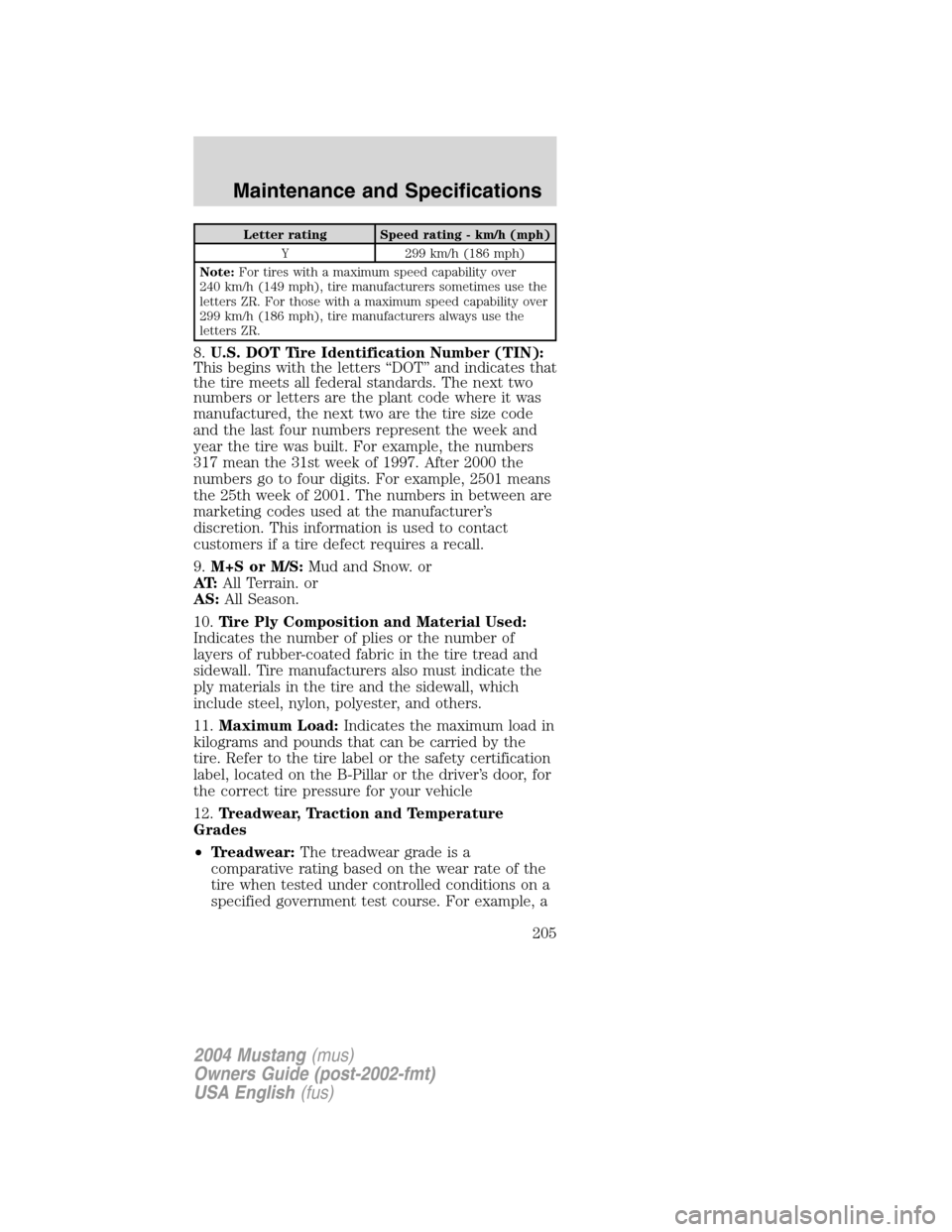
Letter rating Speed rating - km/h (mph)
Y 299 km/h (186 mph)
Note:For tires with a maximum speed capability over
240 km/h (149 mph), tire manufacturers sometimes use the
letters ZR. For those with a maximum speed capability over
299 km/h (186 mph), tire manufacturers always use the
letters ZR.
8.U.S. DOT Tire Identification Number (TIN):
This begins with the letters“DOT”and indicates that
the tire meets all federal standards. The next two
numbers or letters are the plant code where it was
manufactured, the next two are the tire size code
and the last four numbers represent the week and
year the tire was built. For example, the numbers
317 mean the 31st week of 1997. After 2000 the
numbers go to four digits. For example, 2501 means
the 25th week of 2001. The numbers in between are
marketing codes used at the manufacturer’s
discretion. This information is used to contact
customers if a tire defect requires a recall.
9.M+S or M/S:Mud and Snow. or
AT:All Terrain. or
AS:All Season.
10.Tire Ply Composition and Material Used:
Indicates the number of plies or the number of
layers of rubber-coated fabric in the tire tread and
sidewall. Tire manufacturers also must indicate the
ply materials in the tire and the sidewall, which
include steel, nylon, polyester, and others.
11.Maximum Load:Indicates the maximum load in
kilograms and pounds that can be carried by the
tire. Refer to the tire label or the safety certification
label, located on the B-Pillar or the driver’s door, for
the correct tire pressure for your vehicle
12.Treadwear, Traction and Temperature
Grades
•Treadwear:The treadwear grade is a
comparative rating based on the wear rate of the
tire when tested under controlled conditions on a
specified government test course. For example, a
2004 Mustang(mus)
Owners Guide (post-2002-fmt)
USA English(fus)
Maintenance and Specifications
205
Page 206 of 240
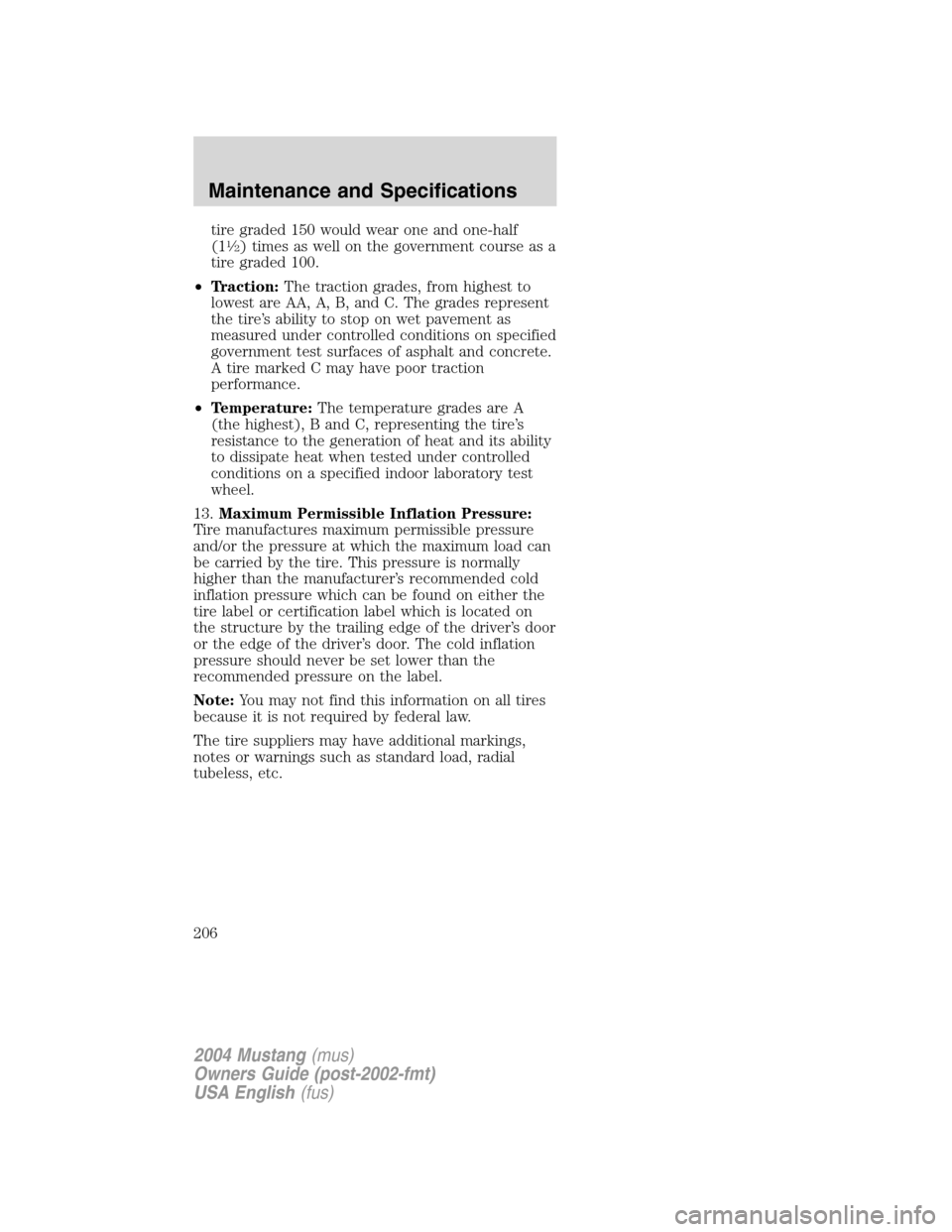
tire graded 150 would wear one and one-half
(11⁄2) times as well on the government course as a
tire graded 100.
•Traction:The traction grades, from highest to
lowest are AA, A, B, and C. The grades represent
the tire’s ability to stop on wet pavement as
measured under controlled conditions on specified
government test surfaces of asphalt and concrete.
A tire marked C may have poor traction
performance.
•Temperature:The temperature grades are A
(the highest), B and C, representing the tire’s
resistance to the generation of heat and its ability
to dissipate heat when tested under controlled
conditions on a specified indoor laboratory test
wheel.
13.Maximum Permissible Inflation Pressure:
Tire manufactures maximum permissible pressure
and/or the pressure at which the maximum load can
be carried by the tire. This pressure is normally
higher than the manufacturer’s recommended cold
inflation pressure which can be found on either the
tire label or certification label which is located on
the structure by the trailing edge of the driver’s door
or the edge of the driver’s door. The cold inflation
pressure should never be set lower than the
recommended pressure on the label.
Note:You may not find this information on all tires
because it is not required by federal law.
The tire suppliers may have additional markings,
notes or warnings such as standard load, radial
tubeless, etc.
2004 Mustang(mus)
Owners Guide (post-2002-fmt)
USA English(fus)
Maintenance and Specifications
206